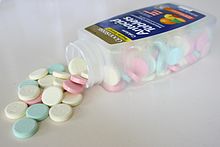Antacid

Antacid tablets
An antacid is a substance which neutralizes stomach acidity and is used to relieve heartburn, indigestion or an upset stomach.[1]
Contents
1 Medical uses
2 Side effects
3 Mechanism of action
4 Formulations and brands
4.1 Effervescents
4.2 Algeldrate
5 References
Medical uses
Antacids are available over the counter and are taken by mouth to quickly relieve occasional heartburn, the major symptom of gastroesophageal reflux disease and also indigestion. Treatment with antacids alone is symptomatic and only justified for minor symptoms.[2]
Antacids are distinct from acid-reducing drugs like H2-receptor antagonists or proton pump inhibitors and they do not kill the bacteria Helicobacter pylori, which causes most ulcers.[2]
Non-particulate antacids (sodium citrate, magnesium trisilicate) increase gastric pH with little or no effect on gastric volume. Sodium citrate should be given within 1 hour of surgery to be the most effective.[3]
Side effects
Versions with magnesium may cause diarrhea, and brands with calcium or aluminium may cause constipation and rarely, long-term use may cause kidney stones. Long-term use of versions with aluminium may increase the risk for getting osteoporosis.[4]
Mechanism of action
When excessive amounts of acids are produced in the stomach the natural mucous barrier that protects the lining of the stomach can damage the esophagus in people with acid reflux. Antacids contain alkaline ions that chemically neutralize stomach gastric acid, reducing damage and relieving pain.[1]
Formulations and brands
Antacids may be formulated with other active ingredients such as simethicone to control gas or alginic acid to act as a physical barrier to acid.[5]
Effervescents
Effervescent tablets are tablets which are designed to dissolve in water, and then release a level of carbon dioxide.[6][7][8] The common ingredients are citric acid and sodium bicarbonate, which react when in contact with water to produce carbon dioxide. Effervescent antacids may also contain aspirin,[9]sodium carbonate, or tartaric acid.[10]
Well known brands are Alka-Seltzer in the United States, along with Eno and Andrews in the United Kingdom.
Algeldrate

Wyeth amphojel tablets of aluminum hydroxide.
Under the generic name algeldrate, aluminium hydroxide is used as an antacid. Aluminium hydroxide is preferred over other alternatives such as sodium bicarbonate because Al(OH)3, being insoluble, does not increase the pH of stomach above 7 and hence, does not trigger secretion of excess stomach acid. Brand names include Alu-Cap, Aludrox, Gaviscon, and Pepsamar. In 2016 Gaviscon was one of the biggest selling branded over-the-counter medications sold in Great Britain, with sales of £62 million.[11] It reacts with excess acid in the stomach, reducing the acidity of the stomach content,[12] which may relieve the symptoms of ulcers, heartburn or dyspepsia. Such products can cause constipation, because the aluminum ions inhibit the contractions of smooth muscle cells in the gastrointestinal tract, slowing peristalsis and lengthening the time needed for stool to pass through the colon.[13] Some such products are formulated to minimize such effects through the inclusion of equal concentrations of magnesium hydroxide or magnesium carbonate, which have counterbalancing laxative effects.
References
^ ab Internal Clinical Guidelines Team (UK) (2014). Dyspepsia and Gastro-Oesophageal Reflux Disease: Investigation and Management of Dyspepsia, Symptoms Suggestive of Gastro-Oesophageal Reflux Disease, or Both. National Institute for Health and Care Excellence: Clinical Guidelines. London: National Institute for Health and Care Excellence (UK). PMID 25340236..mw-parser-output cite.citation{font-style:inherit}.mw-parser-output .citation q{quotes:"""""""'""'"}.mw-parser-output .citation .cs1-lock-free a{background:url("//upload.wikimedia.org/wikipedia/commons/thumb/6/65/Lock-green.svg/9px-Lock-green.svg.png")no-repeat;background-position:right .1em center}.mw-parser-output .citation .cs1-lock-limited a,.mw-parser-output .citation .cs1-lock-registration a{background:url("//upload.wikimedia.org/wikipedia/commons/thumb/d/d6/Lock-gray-alt-2.svg/9px-Lock-gray-alt-2.svg.png")no-repeat;background-position:right .1em center}.mw-parser-output .citation .cs1-lock-subscription a{background:url("//upload.wikimedia.org/wikipedia/commons/thumb/a/aa/Lock-red-alt-2.svg/9px-Lock-red-alt-2.svg.png")no-repeat;background-position:right .1em center}.mw-parser-output .cs1-subscription,.mw-parser-output .cs1-registration{color:#555}.mw-parser-output .cs1-subscription span,.mw-parser-output .cs1-registration span{border-bottom:1px dotted;cursor:help}.mw-parser-output .cs1-ws-icon a{background:url("//upload.wikimedia.org/wikipedia/commons/thumb/4/4c/Wikisource-logo.svg/12px-Wikisource-logo.svg.png")no-repeat;background-position:right .1em center}.mw-parser-output code.cs1-code{color:inherit;background:inherit;border:inherit;padding:inherit}.mw-parser-output .cs1-hidden-error{display:none;font-size:100%}.mw-parser-output .cs1-visible-error{font-size:100%}.mw-parser-output .cs1-maint{display:none;color:#33aa33;margin-left:0.3em}.mw-parser-output .cs1-subscription,.mw-parser-output .cs1-registration,.mw-parser-output .cs1-format{font-size:95%}.mw-parser-output .cs1-kern-left,.mw-parser-output .cs1-kern-wl-left{padding-left:0.2em}.mw-parser-output .cs1-kern-right,.mw-parser-output .cs1-kern-wl-right{padding-right:0.2em}
^ ab U.S. Department of Health & Human Services. Agency for Healthcare Research and Quality 23 September 2011 Consumer Summary – Treatment Options for GERD or Acid Reflux Disease: A Review of the Research for Adults Archived 2014-10-11 at the Wayback Machine
^ Practice Guidelines for Preoperative Fasting and the Use of Pharmacologic Agents to Reduce the Risk of Pulmonary Aspiration: Application to Healthy Patients Undergoing Elective Procedures: An Updated Report by the American Society of Anesthesiologists Task Force on Preoperative Fasting and the Use of Pharmacologic Agents to Reduce the Risk of Pulmonary Aspiration. Anesthesiology. 2017 March; 126(3).
^ U.S. Department of Health and Human Services, National Institutes of Health, U.S. National Library of Medicine. Page last updated: 07 November 2014 Medline Plus: Taking Antacids
^ IFFGD. Antacids Adapted from IFFGD Publication #520 by W. Grant Thompson. Last modified on September 12, 2014
^ Dubogrey, Ilya (2013). "Putting the Fizz into Formulation". European Pharmaceutical Contractor (Autumn).
^ British Pharmacopeia 2003
^ International Pharmacopoeia 2006. World Health Organization. 2006. p. 966. ISBN 978-92-4-156301-7. Retrieved 1 July 2013.
^ "Alka Seltzer Directions of use, Sodium & Aspirin content - Alka Seltzer relief from Headaches, Migraine & Upset stomach". alkaseltzer.ie.
^ Blair, G. T.; DeFraties, J. J. (2000). "Hydroxy Dicarboxylic Acids". Kirk-Othmer Encyclopedia of Chemical Technology. Kirk Othmer Encyclopedia of Chemical Technology. pp. 1–19. doi:10.1002/0471238961.0825041802120109.a01. ISBN 978-0471238966.
^ "A breakdown of the over-the-counter medicines market in Britain in 2016". Pharmaceutical Journal. 28 April 2017. Retrieved 29 May 2017.
^ Galbraith, A; Bullock, S; Manias, E; Hunt, B.; Richards, A. (1999). Fundamentals of pharmacology: a text for nurses and health professionals. Harlow: Pearson. p. 482.
^ Washington, Neena (2 August 1991). Antacids and Anti Reflux Agents. Boca Raton, FL: CRC Press. p. 10. ISBN 978-0-8493-5444-1.
| Look up antacid in Wiktionary, the free dictionary. |